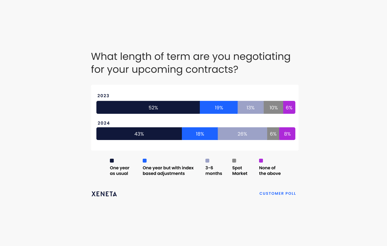Getting a grip on the art of negotiating your ocean shipping rates is an important part of your job and the company’s bottom line.
Whichever forms these negotiations take - either as a direct negotiation, an RFQ or an indirect negotiation - here are some tactics that will help you excel in your ocean freight rate negotiation.
Drop The Boxing Gloves
A get-tough approach might be OK in negotiating a car fleet, but, let’s face it; shipping is not a business environment where you pound your fist until you get the price you want.
Managing uncertainty is part of the game in managing your rate negotiations. How you approach this will significantly affect your relationships down the line. In a supply-demand volatile industry such as shipping, the scales keep tipping from side to side, changing which side is ever really in the driver’s seat.
As one supply-chain pundit warned, the attitude that "whatever price is mentioned must be raised or reduced" is a sign of poor outcomes between any two parties. Allow all your enquiries to signify real steps, however big or small, toward a mutually advantageous business relationship.
True, pricing is negotiable, but how your company approaches carrier rate negotiations may make a great difference to your bottom line. Another reason to trade in the boxing gloves for kid gloves is that going cheap is not always very smart.
Your e-mail spam box is probably full of unsolicited invitations to cut your present relationships out of the picture for their lower rates. The trade-off may hurt in the long run. But, if you make those decisions based on facts and not gut feeling or past relationships, the story may be different.
Research, benchmarking and data trumps fuzzy feelings when it comes to ocean freight procurement.
Related Reading
How to Gain Transparency into Ocean Freight Rates
The Fundamentals In The Freight Negotiation Process
Before your first move in your freight rate negotiation, you want to be smart about the numbers that will come up in the conversation. Know where your estimate stands within the price range for your items. Review all relevant invoices, bill of ladings, carrier contracts and accounting systems that your business accumulated in the past. Feel free to collaborate with other financial experts in your company, to discuss where you can save on freight charges.
Be Aware Of Freight Rate Volatility
Why are prices so volatile? Doesn’t anything stick? The answer is that for every shipping rate negotiation, there is a season. Peak seasons yield higher price estimates. Depending on the nature of your goods, there are slow and heavier seasons and prices reflect supply and demand.
In Asia, for example, from mid-January through early February an upsurge of cargo is evident, as businesses are eager to beat the Chinese New Year deadline when factories may shut down for weeks.
With resulting space problems for cargo to get on to the vessels, rates may rise. In any niche good’s "peak season" where there is a big demand for cargo, rates are high; in turn you need to adjust, and readjust, your expectations.
Another nuance is marketplace quality versus cost-savings and that is where you need to examine your own priorities. Some companies will quote higher but ask yourself two questions: Is the service, beyond the rates, uniquely high? Are they faster than the competition?
Do quality and speed for your line of business matter more than variations in price?
Related Reading
Who Do You Have Your Ocean Freight Contracts With?

Carrier Negotiations: Know Your Market and Service Patterns
Another main point often ignored in shipping rate negotiations is that some customers don’t study the freight market and service patterns covering the different shipping lines operating on that route, who is the best carrier or OTI on that route, the best routing for your cargo etc.
Only through understanding the market and service patterns, you can determine what kind of carrier rate negotiations to enter into. Should you enter into a long term rate, short term rate, quarterly rate, capped rate system etc.
You need to have the knowledge and understanding of the carrier’s operations which could also reveal certain vital information such as where the carrier actually needs their containers and what size/type is required at the destination etc.
This knowledge can help you offer some benefits to the carrier such that they can also reciprocate the same to you in terms of shipping rates.
Shipping rate negotiations are after all a two-way street.
Related reading: How to Select The Right Supplier as a Shipper

Understand The Terms Of Sale
Knowing and understanding the terms of sale and shipment is a crucial factor in shipping rate negotiations. You as the shipper definitely need to be aware of the terms of sale between yourself and your buyer clearly and without any ambiguity.
The terms of sale will be outlined in the sales contract between a seller and buyer and it is essential for you to need to know and understand the Incoterms involved/used, the terms of shipment (CY-CY, CFS-CY etc) and the costs associated with it as these terms will help you identify who pays what charges for a shipment, to whom and the responsibilities thereof.
You may wonder what your terms of sale has to do with the shipping line.
It is worth remembering that in a shipping rate negotiation, the base freight is only one part and there are many charges applicable in the full freight chain.
The costs involved in the full chain must be explored so that the services required from the carrier can be clearly outlined and the rate negotiated suitably.
If not understood and calculated properly, the surcharges applicable could impact on the final result of the negotiations, to the extent of even rendering the gains made on the shipping rate negotiations useless.
Related reading: What is the Cost of Tendering for a Shipper?

Know Your Competition
This is another very important aspect of the shipping rate negotiation with your carrier.
You need to know who your main competitors are in the market, what are their volumes, what are their main routes, what are their weaker routes etc.
Reason is that your competition could be shipping with the same carrier that you are negotiating with and you need to know what kind of rates they are able to secure compared to you.
You should know your competition not just in terms of the shipping rates but also in terms of their business. For example, if their shipping rates are better than yours due to their volumes, but you still have some competitive advantage in other areas such as local haulage and other charges, you could use that as an advantage while pricing.
Related reading: Survival Guide | Ocean Freight Rate Negotiations

Minimise Changes
Once negotiated if you make any changes to your terms of contract or bill of lading such as change in mode of transport (from rail to road for example), these changes will affect your rates.
Changes may not be possible after the goods have arrived to wherever they were assigned.
Keep to your goal to be cost-saving hero without having to shoulder extra fees charged because you amended the Bill of Lading to the point where you incurred extra charges.

Ask For Outside Help If You Need It
Service organizations can help you get the right ocean transportation rates and ocean freight contracts.
They can be called upon to improve the management of rates, routes, schedules and ultimately your entire contract.
Choosing a reliable third party with sophisticated software tools can open your door toward selecting the shipping rates and services that will more than compensate for your having made the investment in outside assistance.
Related reading: How Often Do You Negotiate Ocean Freight Rates?
What Are Freight Rates? Get Rates in Real Time
Disruptions and Innovation are changing today’s supply chain at a rapid clip. As such, ocean freight rates can change at a moment’s notice. Faxes, Excel sheets and phone calls usually used during contract negotiations and general market intelligence, is the story of yesteryear.
Learn how the Xeneta platform works and how you can use it to see how your ocean freight prices perform against the market in real time and on demand. Make sure your supply chain flow is not interrupted and stay abreast of current ocean freight index prices.
- Data for 160,000+ port-port pairs, trade lane corridors
- 23+ million contracted rates
- Turnkey solution; zero implementation effort
How To Negotiate Transportation Rates (SlideShare):







